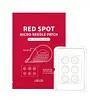What's inside
What's inside
 Key Ingredients
Key Ingredients

 Benefits
Benefits

 Concerns
Concerns

 Ingredients Side-by-side
Ingredients Side-by-side

Sodium Hyaluronate
HumectantSalicylic Acid
MaskingMelaleuca Alternifolia Leaf Extract
PerfumingSalix Alba Bark Extract
AstringentHouttuynia Cordata Extract
Skin ConditioningCentella Asiatica Extract
CleansingPolygonum Cuspidatum Root Extract
AntioxidantScutellaria Baicalensis Root Extract
AstringentCamellia Sinensis Leaf Extract
AntimicrobialGlycyrrhiza Glabra Root Extract
BleachingChamomilla Recutita Flower Extract
MaskingRosmarinus Officinalis Leaf Extract
AntimicrobialHydrolyzed Hyaluronic Acid
HumectantXylitol
HumectantLonicera Japonica Flower Extract
Skin ConditioningPulsatilla Koreana Extract
Skin ConditioningZanthoxylum Piperitum Fruit Extract
Skin ConditioningCitrus Grandis Fruit Extract
AstringentPropanediol
SolventAlcohol Denat.
AntimicrobialIris Florentina Root Extract
MaskingZinc Sulfate
AntimicrobialRetinyl Palmitate
Skin ConditioningPEG-60 Hydrogenated Castor Oil
EmulsifyingSodium Hyaluronate, Salicylic Acid, Melaleuca Alternifolia Leaf Extract, Salix Alba Bark Extract, Houttuynia Cordata Extract, Centella Asiatica Extract, Polygonum Cuspidatum Root Extract, Scutellaria Baicalensis Root Extract, Camellia Sinensis Leaf Extract, Glycyrrhiza Glabra Root Extract, Chamomilla Recutita Flower Extract, Rosmarinus Officinalis Leaf Extract, Hydrolyzed Hyaluronic Acid, Xylitol, Lonicera Japonica Flower Extract, Pulsatilla Koreana Extract, Zanthoxylum Piperitum Fruit Extract, Citrus Grandis Fruit Extract, Propanediol, Alcohol Denat., Iris Florentina Root Extract, Zinc Sulfate, Retinyl Palmitate, PEG-60 Hydrogenated Castor Oil
Water
Skin ConditioningButylene Glycol
HumectantGlycerin
HumectantNiacinamide
SmoothingGlycereth-26
HumectantDimethicone
EmollientBenzyl Glycol
SolventSorbitan Sesquioleate
EmulsifyingBetaine
HumectantPolyglyceryl-4 Caprate
EmulsifyingArginine
MaskingCarbomer
Emulsion StabilisingParfum
MaskingTocopheryl Acetate
AntioxidantTrehalose
HumectantPanthenol
Skin ConditioningChlorphenesin
Antimicrobial1,2-Hexanediol
Skin ConditioningGlyceryl Acrylate/Acrylic Acid Copolymer
HumectantXanthan Gum
EmulsifyingAdenosine
Skin ConditioningDisodium EDTA
Sodium Hyaluronate
HumectantNelumbo Nucifera Phytoplacenta Culture Extract
AntimicrobialDipropylene Glycol
HumectantEthylhexylglycerin
Skin ConditioningPvm/Ma Copolymer
Emulsion StabilisingPEG-35 Castor Oil
EmulsifyingCitrus Limon Fruit Extract
MaskingAlcohol
AntimicrobialHydrogenated Phosphatidylcholine
EmulsifyingAesculus Hippocastanum Seed Extract
Skin ConditioningMacadamia Ternifolia Seed Oil
EmollientCaprylic/Capric Triglyceride
MaskingPolysorbate 20
EmulsifyingHydrogenated Lecithin
EmulsifyingSodium PCA
HumectantSerine
MaskingRetinol
Skin ConditioningTremella Fuciformis Sporocarp Extract
AntioxidantTocopherol
AntioxidantGlycine
BufferingCholesterol
EmollientCeramide NP
Skin ConditioningAlanine
MaskingBrassica Campestris Sterols
EmollientGlutamic Acid
HumectantCeteth-5
EmulsifyingCeteth-3
EmulsifyingInositol
HumectantRetinyl Palmitate
Skin ConditioningCalcium Pantothenate
Potassium Cetyl Phosphate
EmulsifyingLinoleic Acid
CleansingSucrose Stearate
EmollientStearic Acid
CleansingPhytosphingosine
Skin ConditioningPalmitic Acid
EmollientGlycosphingolipids
EmollientBiotin
AntiseborrhoeicWater, Butylene Glycol, Glycerin, Niacinamide, Glycereth-26, Dimethicone, Benzyl Glycol, Sorbitan Sesquioleate, Betaine, Polyglyceryl-4 Caprate, Arginine, Carbomer, Parfum, Tocopheryl Acetate, Trehalose, Panthenol, Chlorphenesin, 1,2-Hexanediol, Glyceryl Acrylate/Acrylic Acid Copolymer, Xanthan Gum, Adenosine, Disodium EDTA, Sodium Hyaluronate, Nelumbo Nucifera Phytoplacenta Culture Extract, Dipropylene Glycol, Ethylhexylglycerin, Pvm/Ma Copolymer, PEG-35 Castor Oil, Citrus Limon Fruit Extract, Alcohol, Hydrogenated Phosphatidylcholine, Aesculus Hippocastanum Seed Extract, Macadamia Ternifolia Seed Oil, Caprylic/Capric Triglyceride, Polysorbate 20, Hydrogenated Lecithin, Sodium PCA, Serine, Retinol, Tremella Fuciformis Sporocarp Extract, Tocopherol, Glycine, Cholesterol, Ceramide NP, Alanine, Brassica Campestris Sterols, Glutamic Acid, Ceteth-5, Ceteth-3, Inositol, Retinyl Palmitate, Calcium Pantothenate, Potassium Cetyl Phosphate, Linoleic Acid, Sucrose Stearate, Stearic Acid, Phytosphingosine, Palmitic Acid, Glycosphingolipids, Biotin
Ingredients Explained
These ingredients are found in both products.
Ingredients higher up in an ingredient list are typically present in a larger amount.
Retinyl palmitate is a form of retinoid. Retinoids are the superstar class of anti-aging ingredients that include tretinoin and retinol.
This particular ingredient has had a bumpy year with its rise and fall in popularity.
First, Retinyl palmitate is created from palmitic acid and retinol. It is a retinol ester and considered one of the weaker forms of retinoid.
This is because all retinoids have to be converted to Tretinoin, AKA retinoic acid. Retinyl Palmitate is pretty far down the line and has to go through multiple conversions before its effects are seen.
Due to this long and ineffective conversion line, the benefits of Retinyl Palmitate are debated.
Studies show Retinyl Palmitate to help:
Dermatologists say this ingredient is ineffective because it isn't used in high enough concentrations in cosmetics.
This ingredient used to be found in sunscreens to boost the efficacy of sunscreen filters.
The downfall of Retinyl Palmitate was due to released reports about the ingredient being correlated to sun damage and skin tumors.
While there is a study showing this ingredient to cause DNA damage when exposed to UV-A, there is no concrete proof of it being linked to skin cancer. It is safe to use when used correctly.
All retinoids increase your skin's sensitivity to the sun in the first few months of usage. Be especially careful with reapplying sunscreen when using any form of retinoid.
Currently, this ingredient is still allowed in cosmetics all over the world. In Canada, cosmetics must have a warning label stating the product to contain Retinyl Palmitate
Fun fact: This ingredient is often added to low-fat milk to increase the levels of Vitamin A.
Learn more about Retinyl PalmitateSodium Hyaluronate is hyaluronic acid's salt form. It is commonly derived from the sodium salt of hyaluronic acid.
Like hyaluronic acid, it is great at holding water and acts as a humectant. This makes it a great skin hydrating ingredient.
Sodium Hyaluronate is naturally occurring in our bodies and is mostly found in eye fluid and joints.
These are some other common types of Hyaluronic Acid:
Learn more about Sodium Hyaluronate